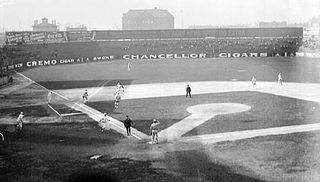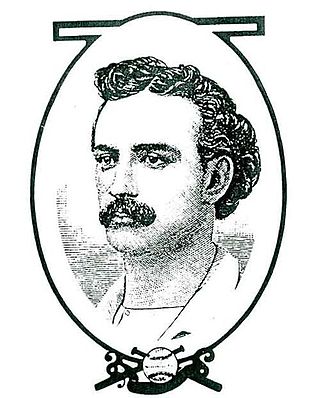Related Research Articles

South Side Park was the name used for three different baseball parks that formerly stood in Chicago, Illinois, at different times, and whose sites were all just a few blocks away from each other.

Lipman Emanuel "Lip" Pike the "Iron Batter", was an American star of 19th-century baseball in the United States. His brother, Israel Pike, played briefly for the Hartford Dark Blues during the 1877 season.
23rd Street Grounds, also known as State Street Grounds and 23rd Street Park, and sometimes spelled out as Twenty-third Street Grounds, was a ballpark in Chicago, in what is now the Chinatown district. In this ballpark, the Chicago White Stockings played baseball from 1874 to 1877, the first two years in the National Association and the latter two in the National League.
The Bank Street Grounds is a former baseball park located in Cincinnati. The park was home to three major league baseball teams. The National League Cincinnati Stars club in 1880, the current Cincinnati Reds franchise from 1882 to 1883 and the Cincinnati Outlaw Reds of the Union Association in 1884. It succeeded the Avenue Grounds as the home site for professional ball in the Queen City.
Olympic Park is the name shared by two former baseball grounds located in Buffalo, New York, United States.

The Troy Trojans were a Major League Baseball team in the National League for four seasons from 1879 to 1882. Their home games were played at Putnam Grounds (1879) and Haymakers' Grounds (1880–1881) in the upstate New York city of Troy, and at Troy Ball Clubs Grounds (1882) across the Hudson in Watervliet, or "West Troy" as it was known at the time.
Cone Athletic Park or Cone Park was the name of two multi-purpose athletic parks that hosted college football and baseball games as well as a minor league baseball team in Greensboro, North Carolina. The first park was built on Summit Avenue in 1902 on donated land. In 1906 it was moved several hundred feet north along Summit Avenue. It was the home of the Greensboro Patriots of the Piedmont League, the North Carolina State League, and other leagues from about 1905 until their move to World War Memorial Stadium in 1930.
The Omaha Packers were a minor league baseball team based in Omaha, Nebraska. Between 1879 and 1935, Omaha minor league teams had a long tenure as members of the Western League and Western Association, winning five league championships. Omaha teams played under numerous other nicknames prior to the becoming the "Packers" in 1930.
References
- Haymakers' Grounds in Troy
- Retrosheet.